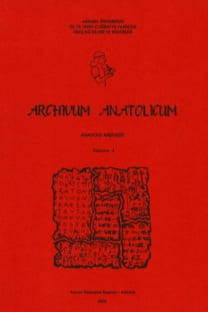YENİ ASUR DÖNEMİNDEN YENİ BİR LİMMU ADI VE TARİHİ ÜZERİNE DEĞERLENDİRME
A Note on a New Eponym Name and its Date from Neo-Assyrian Period
___
- Baker, Heather. The Prosopography of the Neo-Assyrian Empire, Vol. 3/II, 2011.
- Çayır, Murat. “Listelerde Adları Geçmeyen Līmumlar”, ArAn 10/2, (2016): 37-40.
- Çeçen, Salih – Gökçek, L. Gürkan. “Kültepe Tabletlerinde Yerli Tarihleme Usulleri”, Studies in Honor of Hayat Erkanal Cultural Reflections, 2006: 218-221.
- Deller, Karlheinz - Fadhil, Abdullilah. “Neue Nimrud-Urkunden des 8. Jahrhunderts V. Chr.”, BaM 24, (1993): 243-70
- Donbaz, Veysel – Parpola, Simo. Neo-Assyrian Legal Texts in Istanbul, StAt 2. Saarbrücken, 2001.
- Finkel, Irving L. – Reade, Julian. E. “Lots of Eponyms”, Iraq 57, (1995): 167-172.
- Günbattı, Cahit. “An Eponym List (KEL G) from Kültepe”, AoF 35/1, (2008): 103-132.
- Günbattı, Cahit – Çeçen, Salih – Gökçek, L. Gürkan ve Akyüz, Faruk. Kahramanmaraş’ta Bulunmuş Yeni Asurca Tabletler, TTK Yayınları (Basımda).
- Jiménez Enrique – A. Fıstıkçı – S. F. Adalı “Two 7th-Century BCE Neo-Assyrian Slave Sale Records from Marqasi (Kahramanmaraş) in a Collection at Gaziantep”, AoF 42/2, (2015): 173-183.
- Jiménez, Enrique – Adalı, S. Ferruh and Radner, Karen. “Four 7th-Century BCE NeoAssyrian Slave Sale Records from Marqasi (Kahramanmaraş) in the Erimtan Museum (Ankara) and Elsewhere”, AoF 42/2, (2015): 153-172.
- Kwasman, Theodore. Legal Transactions of the Royal Court of Nineveh, Part I: Dated and Datable Texts, SAA 6. Helsinki, 1991.
- Larsen, M. Trolle. “Unusal Eponym-Datings from Mari and Assyria”, RA 68, (1974): 15-24.
- Mattila, Raija. Legal Transactions of the Royal Court of Nineveh, Part II: Assurbanipal through Sîn-šarru-iškun, SAA 14. Helsinki, 2002.
- Millard, Alan. “Observations from the Eponym Lists”, Assyria 1995, (1997): 207-211.
- Millard, Alan. The Eponyms of the Assyrian Empire, 910-612 BC, SAAS II, Helsinki, 1994.
- Parpola, Simo. "Texts with Eponyn Dates", in K. Radner (ed.), Prosopography of the Neo-Assyrian Empire, PNA 1/I, Helsinki, 1998, XVIII-XX.
- Postgate, J. Nicholas. The Governers Palace Archive, CTN II, London, 1973.
- Radner, Karen – Schachner, Andreas. “Tušhan'dan Amēd൴'ye: Asur Dönem൴nde Yukarı D൴cle Havzasıyla İlg൴l൴ Topograf൴k Sorular = From Tushan to Amed൴ : Topographical Questions concerning the Upper Tigris Region in the Assyrian Period”, Ilısu ve Karkamış Baraj Gölleri Altında Kalacak Arkeolojik ve Kültür Varlıklarını Kurtarma Projesi 1999 Yılı Çalışmaları, Ankara, 2001, 729-776.
- Reade, Julian. “Assyrian Eponyms, Kings and Pretenders, 648-605”, Or. NS 67, (1998): 255-265.
- Veenhof, Klass R. The Old Assyrian List of Year Eponyms Corrections, Additions and Its Chronological Implications, TTK Yayınları VI/64, Ankara, 2003.
- Zawadzki, Stefan. “The Question of the King’s Eponymate in the Latter Half of the 8th Century and the 7th Century BC”, Assyria 1995, Helsinki, 1997: 383-389.
- ISSN: 1300-6355
- Yayın Aralığı: 2
- Başlangıç: 1995
- Yayıncı: Ankara Üniversitesi Dil ve Tarih-Coğrafya Fakültesi
YENİ ASUR DÖNEMİNDEN YENİ BİR LİMMU ADI VE TARİHİ ÜZERİNE DEĞERLENDİRME
ÇİVİ YAZILI BELGELER VE ARKEOLOJİK VERİLERE GÖRE ESKİ BABİL DÖNEMİNDE NEHİR ULAŞIMI
İrfan ALBAYRAK, Esma ÖZ KİRİŞ, Hakan EROL
HİTİTÇE METİNLERDE GEÇEN BAZI YEREL ŞARKICILAR ÜZERİNE
KUZEY LYKIA’DAN YENİ BİR YAPI YAZITI
Bülent İPLİKÇİOĞLU, Ayşe YAKUT
ESKİ MEZOPOTAMYA KÜLTÜRÜNDE TILSIM İNANIŞI VE BAZI TILSIMLI OBJELER
